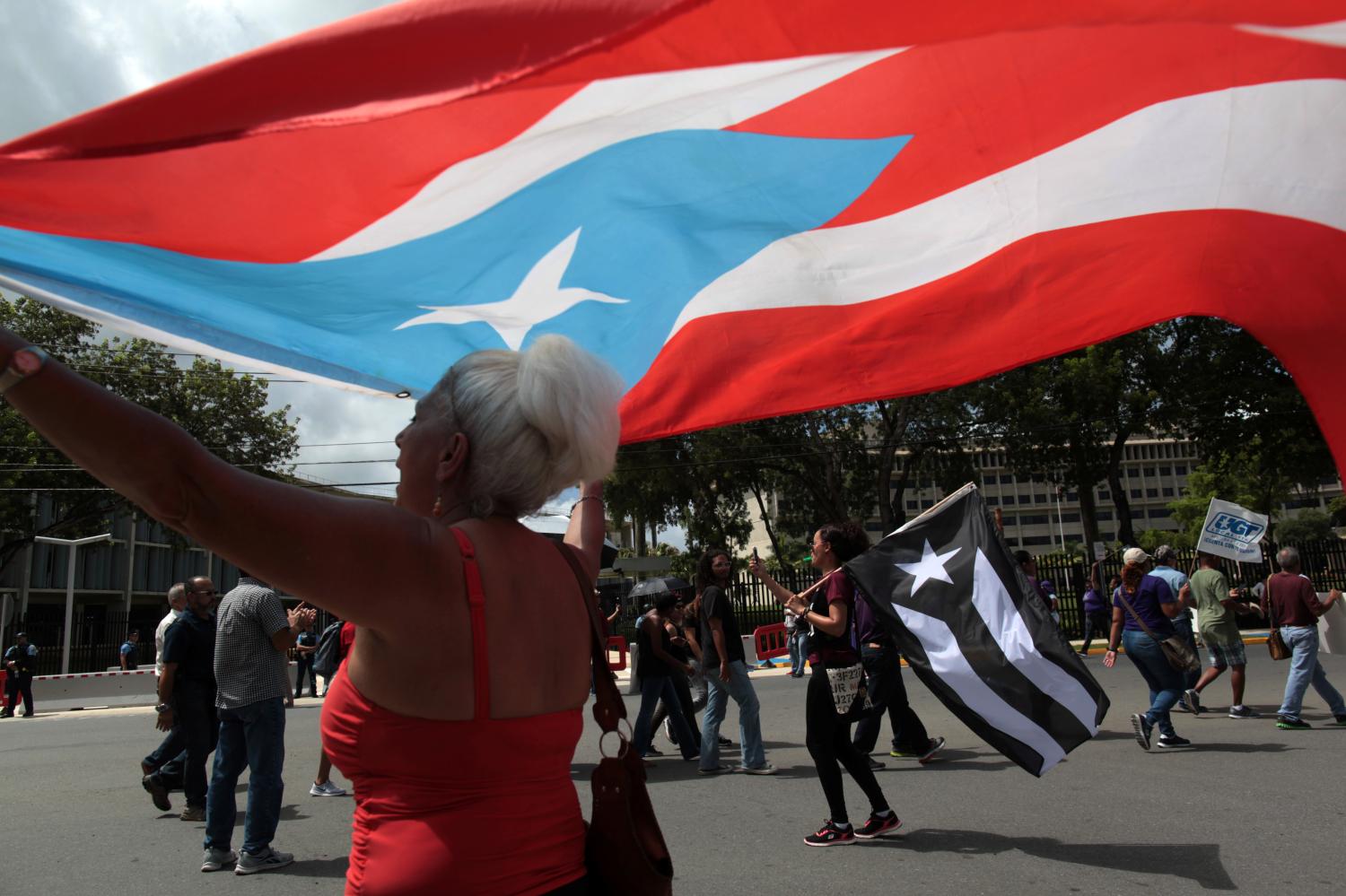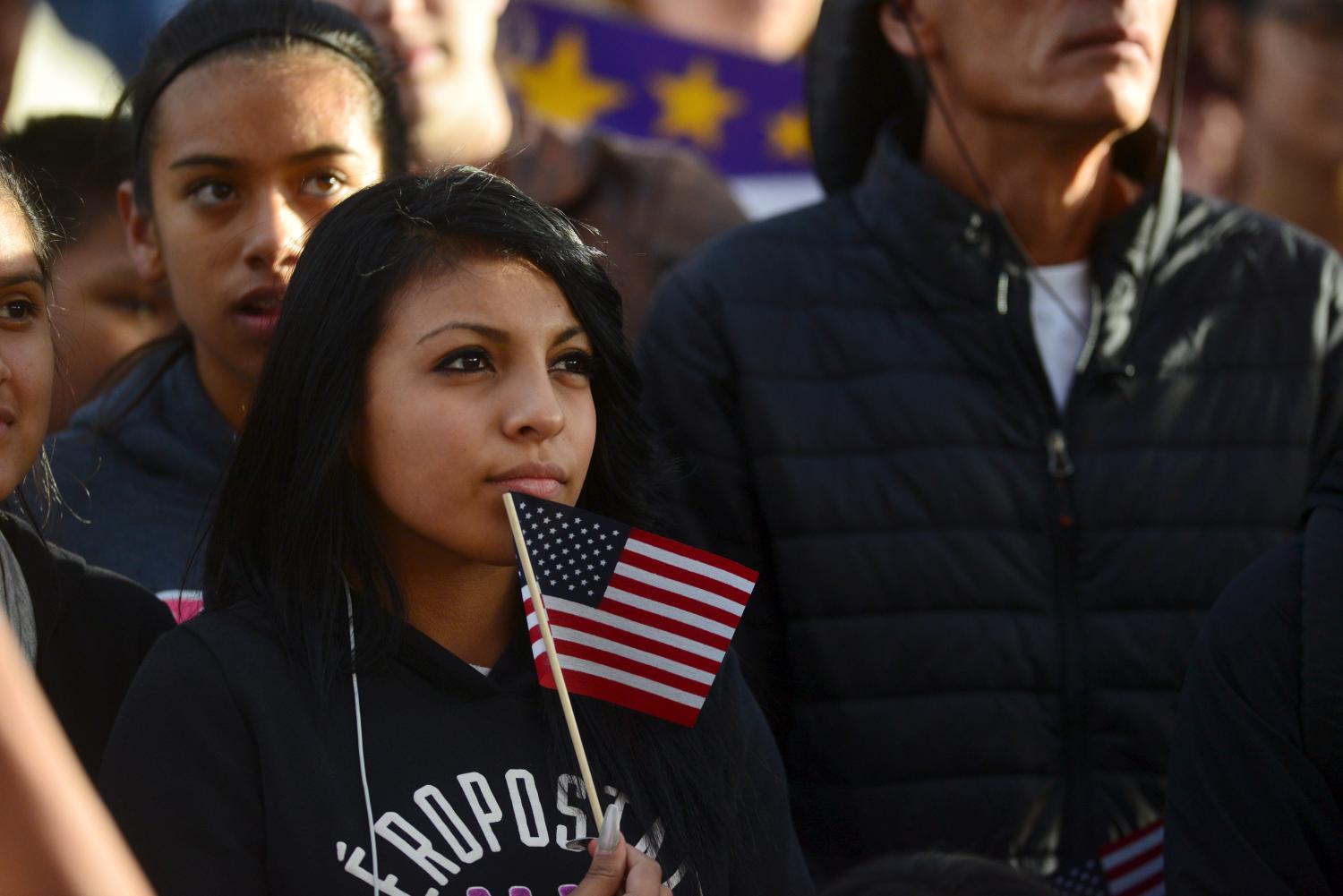Puerto Rico narrowly escaped the worst of Hurricane Irma this week, but another storm is brewing on the island, and this one will not blow over any time soon. The hurricane comes in the midst of a political battle resulting from a deep fiscal crisis, which is in turn a symptom of long-run structural economic weakness. President Trump has authorized federal disaster relief efforts in Puerto Rico response to the hurricane. But with a child poverty rate of 58 percent and a woefully overburdened public health care system, the island could use more than short-term aid. Will the U.S. remember Puerto Rico when Irma has come and gone?
Puerto Rican politics turns uglier
The political fight is between Puerto Rico’s Financial Oversight and Management Board (FOMB), and the island’s governor, Ricardo Rosselló, as well as a hedge fund that holds about $470 million in Puerto Rico’s general obligation bonds. The FOMB was established by Congress last year to set Puerto Rico on the path to fiscal solvency after the commonwealth defaulted on a series of payments on its $74 billion public debt—$123 billion if you count unfunded pension liabilities.
Last month, the board announced some austerity measures, including furloughs of two days per month for all public employees (except police) that were to start in September, to achieve $218 million in annual savings.
Rosselló has announced that he will not cooperate with additional austerity measures adopted by the FOMB. The board has since sued the governor on the basis that he does not have the authority to reject the austerity measures, though Rosselló has indicated that he’s willing to go to jail to stop the furloughs.
At the same time, the board is now the subject of a lawsuit filed in August by Aurelius Capital, one of the holdout hedge funds that profited hugely in Argentina after that country defaulted in 2001.
Some additional context is needed here: as a U.S. territory, Puerto Rico can’t file for municipal bankruptcy under Chapter 9 of the U.S. bankruptcy code. But the Puerto Rico Oversight, Management, and Economic Stability Act (PROMESA), which created the board, gives territories the option to file for quasi-bankruptcy.
Under the PROMESA plan, the governor was required to produce a fiscal plan that would close the island’s budget gap, with the FOMB’s seal of approval. This happened in March: after approving Rosselló’s austerity plan, the board started bankruptcy-like proceedings in May to protect Puerto Rico from its creditors.
Last year, Puerto Rico’s creditors were strongly in favor of a fiscal control board in Puerto Rico that would protect their interests. They have changed their tune now that it looks like bondholders will be taking a major haircut. Aurelius Capital claims that since the board’s members weren’t approved by the U.S. Senate, its decisions—and thus Puerto Rico’s bankruptcy-like proceedings—are void. (The hedge fund probably won’t win its case.)
All of this may seem like a local problem. But the federal government is intimately involved in Puerto Rico’s prospects. The U.S. government has a necessary concern in the humanitarian crisis impacting the 3.4 million U.S. citizens on the island. Puerto Rico’s fiscal crisis also provides a cautionary take for states like Illinois and New Jersey, who also appear to have taken on unsustainable levels of long-term debt.
The fiscal crisis
In addition to the $74 billion owed to bondholders, Puerto Rico has about $50 billion in unfunded pension liabilities, $13 billion of which is owed to retired teachers. Since the public pension system is out of money, Governor Rosselló, who inherited this situation when he took office in January, is switching to a pay-as-you-go model to cover existing obligations. This means that this year’s pension payments will come out of the government’s tax revenues. New hires and active employees will be isolated in a separate defined contribution plan, so their contributions won’t be used to pay off immediate obligations. The original pension plan was to distribute the cut progressively based on income, with no cuts to retirees under the poverty line.
Earlier this year, the governor also agreed to reduce pension benefit outlays by 10% by 2020. There were also proposed reductions in agency and municipal budgets that will likely lead to layoffs. Given that about one in five people employed in Puerto Rico works for the government, pension and personnel reductions are going to hurt.
Now, however, his administration says that the pension cut, like the furloughs, was merely a recommendation—one that the government won’t follow. The FOMB has taken the fight to court, since these were the plans approved earlier in the year.
In 1974, during an economic crisis and battle with trade unions, British Prime Minister Ted Heath called an election over the question, as he put it, of “Who Governs Britain?” (He lost.) In similar vein, the question has to be answered, legally or politically, “Who Governs Puerto Rico?”
Economic weakness
Puerto Rico’s legal, political and fiscal problems are all symptoms of a decade-long economic crisis, which shows few signs of letting up.
The island has lost 10% of its population since 2007—mostly professionals looking for opportunity on the mainland. At least one doctor left Puerto Rico every day in 2016, according to NPR. The College of Physicians and Surgeons of Puerto Rico say the number is even higher, at two doctors per day. In 2016, Puerto Rico had just 9,000 working physicians—down 36% from 2006.
 As the school-age population has shrunk, Puerto Rico has consolidated underutilized schools to save on building costs. An additional 167 schools are set to close this year, though the governor claims that his fiscal plan will not require layoffs. Still, teachers are among the public employees facing FOMB furloughs, meaning children might spend less time in school this year.
As the school-age population has shrunk, Puerto Rico has consolidated underutilized schools to save on building costs. An additional 167 schools are set to close this year, though the governor claims that his fiscal plan will not require layoffs. Still, teachers are among the public employees facing FOMB furloughs, meaning children might spend less time in school this year.
A Closer look at healthcare
One of the major components of Puerto Rico’s fiscal plan is a reform of the island’s overburdened public health care system, intended to generate $6 billion in savings on public health care spending over the next 10 years, an average annual reduction of 6% in total public and private health care spending on the island.1
Cuts to public health care spending are likely to hit hard, since about half of the population is covered by Medicaid:

Because Puerto Ricans do not pay the federal personal income tax, the island receives less federal Medicaid funding than it would if it were a state. In 2011, the match rate for Puerto Rico and other territories was increased from 50% to 55%—still much lower than rates for states with similar incomes. Mississippi, for example, has a 76% match rate.
Matching funds for territories, unlike states, are also capped. Once a territory hits its federal funding ceiling, the match rate becomes 0%. Puerto Rico’s federal Medicaid funding is essentially a block grant, since the territory always hits its cap. According to the Atlantic, Puerto Rico’s federal funding amounted to $329 million in 2015. This covered 14% of Medicaid costs that year.
The Affordable Care Act provided Puerto Rico with an additional $5.4 billion in Medicaid funding for 2011 through 2019, but that money will actually run out by the end of 2017. In the past, Puerto Rico has tended to pay for remaining Medicaid costs by issuing municipal bonds. (Thus the debt crisis.) That is no longer an option, since it has lost access to capital markets.
Putting a face on the fiscal crisis
Puerto Rico’s poverty rate is 46%, more than twice the poverty rate in Mississippi, the poorest state in the U.S. The child poverty rate is even higher, at 58%:

Over four out of five children in Puerto Rico live in a Census tract with a poverty rate of over 30%, according to Kids Count:

Children in high-poverty areas, even those from non-poor families, are exposed to higher crime rates, worse health outcomes, and poorer-performing schools, among other barriers to social mobility.
The island’s unemployment rate is also twice as high as the U.S. average. In June 2017, Alaska had the highest unemployment rate of any U.S. state at 6.8%. But the rate in Puerto Rico is 10.1%. Over half of children in Puerto Rico live in families where no parent has regular, full-time employment, making them especially vulnerable to economic shocks.
Working toward recovery
Ultimately, what Puerto Rico needs are jobs and people with the skills to fill them. To encourage business activity, Puerto Rico will need to show potential employers that it has the human capital to supply their needs.
But the depth and pervasiveness of Puerto Rico’s poverty doesn’t bode well for investment in human capital—especially for the island’s children, its future workforce. And as the crisis continues, workers and entrepreneurs will continue to leave for the mainland.
Puerto Rico’s unemployment rate has actually been declining since 2010, but that doesn’t mean that the island has added more jobs. It likely means that the existing stock of jobs is getting shuffled around as workers leave for the mainland. The labor force—the sum of the employed and unemployed populations—has shrunk by about 20 percent since 2007, though this trend has slowed somewhat in recent years2:

High unemployment rates are one sign of a more pervasive problem on the island: low labor force participation. Puerto Rico’s June 2017 labor force participation rate was 40%—meaning that only 40% of adults over the age of 15 were employed or actively seeking employment. This compares to a rate of 62.8% in the United States. (West Virginia had the lowest labor force participation rate of any state at 57%):

The migration of many native Puerto Ricans to the mainland isn’t helping the island’s labor supply, especially since those who leave are more likely to be in the workforce than those who stay. Puerto Rico is stuck in a negative feedback loop: as economic prospects worsen, working people leave for the mainland, leaving the island with limited human capital to fuel economic development.
To break the cycle, the governor is using a combination of tax incentives and labor reform to incentivize business activity and lure young professionals back to Puerto Rico. This might be showing some signs of success. The governor’s fiscal plan also contain proposals to encourage business activity and to expedite “critical projects,” mostly in energy and transportation. But it is far from clear that these initiatives, even if the current political impasse is broken, can offset years of economic decline and the new cuts.
is statehood the answer?
It would of course be in Puerto Rico’s best interest to get the benefits of statehood without the costs. Mainlanders are understandably wary of that idea. And full statehood is unpopular with many Puerto Ricans. The recent statehood referendum was widely boycotted: 97% of ballots cast supported statehood, but only 23% of voters showed up to the polls. Voter participation in Puerto Rico is usually around 80%.
Unfortunately for Puerto Rico, any further proposals for federal funding to the island will continue to face opposition in Congress on the basis that territories don’t pay the federal personal income tax. This is the main reason for less generous Medicaid funding. It also explains why Puerto Rican workers don’t have access to the Earned Income Tax Credit (EITC). Further, only Puerto Rican families with more than three children receive the Child Tax Credit (CTC), a partially refundable tax credit that in U.S. states is available to working families who have one or more children.
The EITC and the CTC have been shown to promote work, reduce poverty, and improve children’s outcomes in the U.S. Puerto Rico could use that kind of boost.
The Youth Development Institute of Puerto Rico (YDI) recommends (among other proposals) that the U.S. extend these work tax incentives to Puerto Rico. The Obama administration proposed something similar in 2016. In a 2006 book, our colleague Gary Burtless and Orlando Sotomayor recommended reforming the island’s system of public transfers to reward work, such as by offering a work tax credit on the island (possibly replacing some less effective public transfers).
Puerto Rico could create its own EITC-like program—except that the government is bankrupt and scrambling to reduce spending. It remains unlikely that the U.S. Congress will offer the EITC to people living in place where nobody pays federal personal income tax (even though people who receive the EITC are often exempt from this tax).
So what if Puerto Ricans did pay the federal personal income tax? Imposing more taxes on an impoverished population sounds counterproductive. But given the high poverty rate, many Puerto Ricans would not be liable for the tax. Even a family with earnings equal to Puerto Rico’s median income, $18,626 in 2015, would receive more in refundable tax credits than they would pay in federal income taxes.3
Revenue from the income tax could pay for more equitable federal Medicaid funding. The GAO estimates that if Puerto Rico had been a state in 2010, the island would have paid as much as $2.3 billion in individual income taxes after accounting for refundable tax credits. Federal Medicaid funding would have been between $1.1 and $2.1 billion in FY 2011 if Puerto Rico were a state, according to the GAO. (Actual funding that year was $685 million.)
This suggests that Puerto Rico could close its Medicaid funding gap without federal aid by imposing a clone of the federal income tax. Of course, any proposal to increase income taxes is bound to be unpopular at a time when the government is trying to save the economy—especially given that Puerto Rico’s income tax rates are already higher than state income tax rates.
What can the u.s. do?
In the immediate future, the U.S. could help Puerto Rico avoid further austerity measures by increasing Medicaid funding. This wouldn’t solve all of the island’s problems, but healthy population makes for a more productive workforce. And it might allow Puerto Rico to free up resources for economic recovery in addition to balancing the budget.
In May, Congress agreed to provide Puerto Rico with an extra $295 million. But this is a Band-Aid. The U.S. could permanently ameliorate Puerto Rico’s fiscal crisis by funding the island’s Medicaid program just like a state’s—something the Obama administration suggested last year.
Disparities in funding may be justified by differences in tax liabilities: but we should be clear about the implications. Puerto Rico is part of the U.S., whether the rest of the country knows that or not. Right now, the implication of federal health care spending is that the health and lives of U.S. citizens in Puerto Rico are worth less than the health and lives of U.S. citizens on the mainland.
Congress could be a major player in Puerto Rico’s recovery. Or, a year after the passage of PROMESA, it could wipe its hands of the island and say, “We tried.” The U.S. must determine whether it’s willing to provide Puerto Rico with additional relief without getting anything in return.
Let’s see if Congress will act.
-
Footnotes
- Public and private health care spending in Puerto Rico amounted to about $10.9 billion in 2014 (down from $12.1 billion in 2010). If the government spends an annual average of $0.6 billion (one tenth of the total $6 billion savings) less on health care than it would have in the absence of cuts, annual spending is reduced by 5.5% ($0.6 billion divided by $10.9 billion).
- Labor force includes those employed plus those unemployed.
- For the 2016 tax year, the standard deduction for a head of household was $9,300. With a personal exemption of $4,050 per person, a single parent with one dependent and $18,626 in annual earnings would have had $1,226 in taxable income. At a tax rate of 10%, that’s about $123 in federal income taxes. According to the Center for Budget and Policy Priorities, a single parent earning $18,626 qualifies for an EITC of $3,303. Since the EITC is fully refundable, this family would receive a refund of $3,180 from the Federal Government ($4,180 with the Child Tax Credit).
The Brookings Institution is committed to quality, independence, and impact.
We are supported by a diverse array of funders. In line with our values and policies, each Brookings publication represents the sole views of its author(s).






